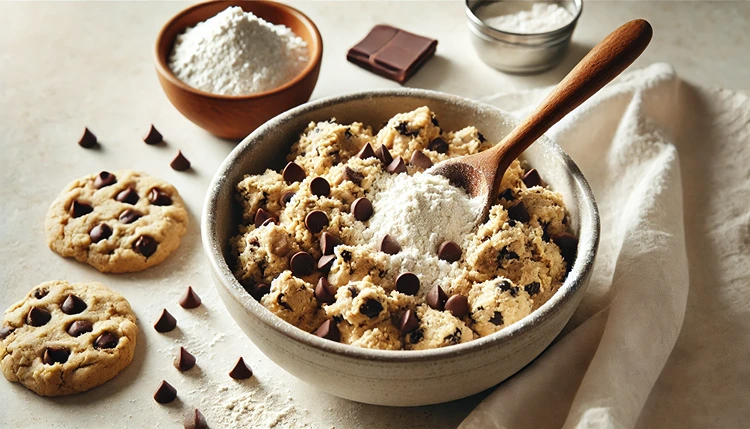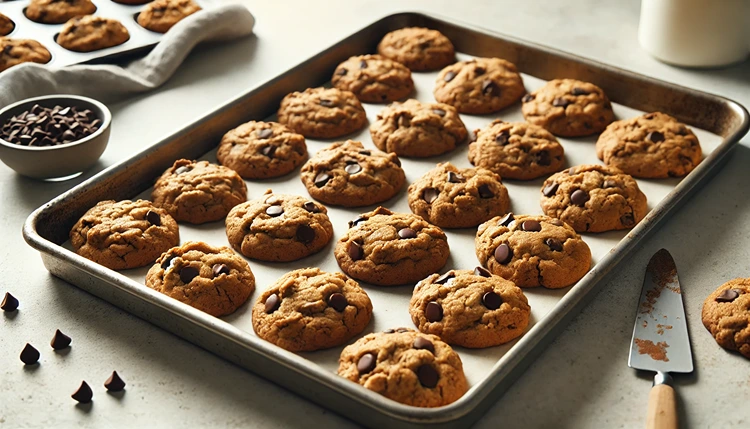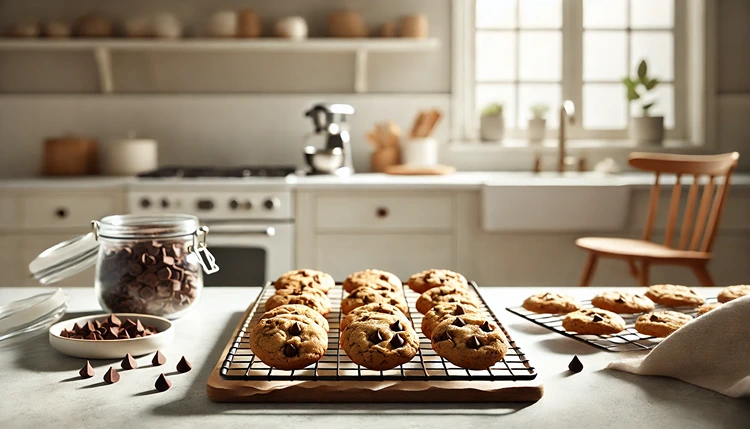If you’re trying to bake the perfect gluten-free chocolate chip cookies, coconut flour can be a game changer. Unlike traditional flours, it absorbs more liquid, making it a unique baking ingredient. Coconut flour is gluten-free, low-carb, and packed with fiber. Plus, it adds a hint of natural sweetness to your recipes without overpowering other flavors. This is why it pairs so well with chocolate chips in cookies—giving you a satisfying, chewy texture with just the right amount of sweetness.
Why coconut flour though? When you’re living a gluten-free lifestyle, your options for flour can feel limited. Coconut flour steps in as a great alternative that’s not only nutritious but also versatile. It’s especially fantastic in cookie recipes, where its absorbency helps create a chewy yet soft texture that most gluten-free flours can’t quite replicate.
How Does Coconut Flour Compare to Other Gluten-Free Flours?
When it comes to gluten-free flours, there are a lot of options—almond flour, rice flour, oat flour, and of course, coconut flour. So, what makes coconut flour stand out? First, it’s highly absorbent. That means you’ll need less flour in your recipes compared to others. Second, coconut flour has a slightly sweet, tropical flavor, which works great in dessert recipes like chocolate chip cookies. Lastly, it’s rich in fiber and healthy fats, making it not only a gluten-free alternative but a more nutritious one.
Helpful Hint:
Because coconut flour is so absorbent, you’ll need more liquid in your recipes. If you’re substituting coconut flour in a standard recipe, aim to use about 1/4 cup of coconut flour for every 1 cup of wheat flour and add an extra egg or more liquid to balance the texture.
Coconut Flour vs Almond Flour for Gluten-Free Baking
| Feature | Coconut Flour | Almond Flour |
|---|---|---|
| Absorbency | Highly absorbent, requires more liquid | Less absorbent, closer to regular flour |
| Flavor | Mild, slightly sweet with a hint of coconut | Nutty, rich flavor |
| Texture | Produces a denser texture, requires more eggs | Light, fluffy texture in baked goods |
| Nutrition | High in fiber, low in carbs | High in protein, low in carbs |
| Calories (per 1/4 cup) | 120 calories | 160 calories |
What Ingredients Are Essential for Gluten-Free Coconut Flour Cookies?
Now that we’ve covered why coconut flour is such a great option, let’s dive into the ingredients that make these gluten-free chocolate chip cookies irresistible. Each ingredient plays a key role in ensuring that these cookies turn out soft, chewy, and packed with flavor.
- Coconut Flour: The star of the show. Remember, it’s highly absorbent, so you’ll use less than you would with traditional flour.
- Eggs: Essential for binding the dough together and adding moisture. Since coconut flour can make baked goods dry, eggs help counterbalance that.
- Coconut Oil or Butter: Fat is important for giving the cookies a rich, moist texture. Coconut oil enhances the natural coconut flavor, while butter gives a more traditional cookie taste.
- Chocolate Chips: Semi-sweet or dark chocolate chips work best to add a touch of indulgence to every bite.
- Sweeteners: Maple syrup, honey, or coconut sugar are great natural sweeteners that complement the coconut flour’s subtle sweetness.
- Baking Soda: Helps the cookies rise, giving them that perfect cookie texture with a slight crisp around the edges.
- Vanilla Extract: Adds a depth of flavor that enhances the overall taste without overwhelming the chocolate chips.
Are There Any Special Tips for Baking with Coconut Flour?
Because coconut flour behaves differently from regular flour, there are a few tips that can help ensure your cookies come out perfect every time. First, always measure your coconut flour carefully. Since it absorbs more liquid, using too much can make your cookies dry. It’s also important to use enough liquid and fat (like eggs and coconut oil) to balance the flour’s absorbency. Finally, give your dough time to rest before baking. This allows the coconut flour to fully absorb the liquid, creating a better texture in the final product.
Helpful Hint:
If your cookie dough looks a little dry, don’t panic. Coconut flour absorbs moisture over time, so give your dough a few minutes to rest. If it still seems too dry, feel free to add a splash of almond milk or another liquid to adjust the consistency.
How to Make Gluten-Free Chocolate Chip Cookies with Coconut Flour

Ready to bake some cookies? Here’s a step-by-step guide to making the best gluten-free chocolate chip cookies using coconut flour. These cookies are not only gluten-free but also refined sugar-free, making them a healthier treat option.
Gluten-Free Chocolate Chip Cookies with Coconut Flour
Prep Time: 10 minutes | Cook Time: 12 minutes | Total Time: 22 minutes

Ingredients
- 1/2 cup coconut flour
- 1/4 cup coconut oil or butter, melted
- 1/4 cup maple syrup or honey
- 2 large eggs
- 1/2 tsp vanilla extract
- 1/4 tsp baking soda
- 1/2 cup semi-sweet or dark chocolate chips
Instructions
- Preheat your oven to 350°F (175°C) and line a baking sheet with parchment paper.
- In a large bowl, whisk together the eggs, melted coconut oil, maple syrup, and vanilla extract until smooth.
- In a separate bowl, mix the coconut flour and baking soda.
- Slowly add the dry ingredients to the wet ingredients, stirring until fully combined.
- Fold in the chocolate chips.
- Scoop tablespoon-sized balls of dough onto the prepared baking sheet and flatten slightly.
- Bake for 10-12 minutes or until the edges start to turn golden brown.
- Let the cookies cool on the baking sheet for 5 minutes before transferring to a wire rack to cool completely.
These cookies are quick to make, and the coconut flour gives them a unique texture you won’t get from other gluten-free options. The result? A cookie that’s soft, chewy, and packed with chocolate chips in every bite.
Can You Customize These Gluten-Free Chocolate Chip Cookies?
One of the best things about baking gluten-free chocolate chip cookies with coconut flour is how versatile the recipe is. You can easily tweak it to suit your preferences or dietary needs. For example, if you’re looking to cut back on sugar, you can swap the maple syrup or honey for a sugar-free sweetener like monk fruit. You can also use dairy-free chocolate chips and coconut oil to make these cookies fully dairy-free and paleo-friendly.
Helpful Hint:
To make your cookies more fun, add a handful of chopped nuts, dried fruit, or even shredded coconut. Just make sure to adjust the dough consistency if you’re adding extra ingredients to keep everything balanced.
What’s the Texture Like for These Gluten-Free Cookies?
Wondering what to expect when you bite into one of these cookies? Coconut flour can give baked goods a slightly denser texture than all-purpose flour. However, when used correctly, it results in a chewy, soft cookie with crispy edges. The balance of eggs, fat, and coconut flour ensures that the cookies aren’t crumbly, which can be a challenge in gluten-free baking. Each bite gives you a soft center with melty chocolate chips, wrapped in a slightly crisp outer layer.
Since coconut flour is more absorbent than other gluten-free flours, it helps the cookies hold their shape while remaining soft inside. This makes them perfect for anyone who loves a cookie with a bit of bite, but without the crumbly mess that sometimes comes with gluten-free treats.
Why Do My Gluten-Free Cookies Turn Out Dry?

It’s a common issue when baking with coconut flour: dry, crumbly cookies. So, what’s the cause? Coconut flour is highly absorbent, meaning it soaks up liquids faster than traditional or other gluten-free flours. If you don’t adjust the amount of liquid or fat in the recipe, your cookies can end up too dry. The solution? Add more eggs or liquid (such as almond milk), and make sure you’re not using too much flour.
Another key is to keep a close eye on your cookies while they bake. Overbaking is a frequent culprit for dry cookies. Coconut flour bakes faster than all-purpose flour, so make sure to check the cookies for doneness around the 10-minute mark. They should be slightly golden at the edges but still soft in the center when you pull them out of the oven. As they cool, they’ll firm up.
How Can I Fix Dry Dough When Baking Gluten-Free?
If your dough seems dry or crumbly before baking, don’t worry. There’s still time to fix it! Here are a few easy solutions:
- Add More Liquid: If the dough feels dry, add a tablespoon of almond milk or water and mix until the dough reaches a moist consistency. Keep adding liquid, one tablespoon at a time, until the texture improves.
- Use an Extra Egg: Eggs are not only for binding but also for moisture. If you’re finding your dough isn’t holding together well, try adding one more egg to help keep it moist.
- Rest the Dough: Let the dough sit for 5-10 minutes before scooping it onto the baking sheet. This allows the coconut flour to fully absorb the liquids and can improve the texture.
Why Is Coconut Flour So Absorbent?
You might wonder why coconut flour behaves so differently from other gluten-free flours. The answer lies in its composition. Coconut flour is made from dried coconut meat that’s been finely ground, making it rich in fiber. This high fiber content means that it soaks up liquid more quickly than most flours. While this can create challenges in baking, the good news is that it helps keep your cookies from spreading too much, resulting in a perfectly shaped cookie every time.
How Does Coconut Flour Impact the Flavor of Cookies?
Coconut flour has a subtle sweetness and a mild coconut flavor that works really well in dessert recipes, especially cookies. If you’re worried about your cookies tasting too “coconutty,” don’t be! The flavor of coconut flour is delicate and won’t overpower the chocolate chips or other ingredients in your cookies. In fact, it complements them nicely. And if you’re using vanilla extract and a sweetener like maple syrup or honey, the coconut flavor becomes even less noticeable, blending into the background of the overall cookie taste.
Can I Use a Substitute for Eggs in This Recipe?
If you’re following an egg-free diet or need to accommodate an egg allergy, you can still make these gluten-free chocolate chip cookies with coconut flour. The key is to find a suitable egg replacement that binds the dough and adds moisture. Here are a few options that work well:
- Flax Egg: Combine 1 tablespoon of ground flaxseed with 3 tablespoons of water, stir, and let it sit for 5-10 minutes to thicken. This mixture acts as a great binder in gluten-free baking.
- Chia Egg: Similar to the flax egg, mix 1 tablespoon of chia seeds with 3 tablespoons of water, then let it thicken before adding it to your dough.
- Applesauce: You can also replace each egg with 1/4 cup of unsweetened applesauce for added moisture. Just be mindful that applesauce will make the cookies a little softer and denser.
Helpful Hint:
If you’re substituting eggs, keep in mind that the dough may need a bit more liquid since coconut flour is so absorbent. Start with the base substitution, but don’t hesitate to add a tablespoon of water or almond milk if the dough feels too dry.
How to Store Gluten-Free Chocolate Chip Cookies
Once your cookies are baked to perfection, you’ll want to store them properly to maintain their freshness. Luckily, these gluten-free chocolate chip cookies with coconut flour are easy to store and even freeze for later.
Storing at Room Temperature
If you plan to eat your cookies within a few days, you can store them in an airtight container at room temperature. Be sure to place a sheet of parchment paper between layers of cookies to prevent them from sticking together. Stored this way, the cookies should stay fresh for up to 3 days.
Refrigerating or Freezing for Longer Storage
For longer storage, you can refrigerate the cookies in an airtight container for up to a week. Alternatively, these cookies freeze beautifully. Place them in a single layer on a baking sheet and freeze until solid, then transfer them to a freezer-safe bag or container. When you’re ready to enjoy them, simply let them thaw at room temperature or give them a quick reheat in the oven.
Can I Make the Dough Ahead of Time?
If you want to get ahead on your cookie prep, the good news is that you can make the dough ahead of time and refrigerate it for up to 2 days. Simply cover the dough tightly with plastic wrap or store it in an airtight container. When you’re ready to bake, let the dough come to room temperature for about 10-15 minutes before scooping it onto the baking sheet.
You can also freeze the dough for up to 3 months. To do this, scoop the cookie dough into balls and place them on a parchment-lined baking sheet. Freeze until solid, then transfer the dough balls to a freezer-safe bag. When you’re ready to bake, there’s no need to thaw the dough—just add a minute or two to the baking time.
What Are Some Variations of This Gluten-Free Chocolate Chip Cookie Recipe?
One of the fun aspects of baking is experimenting with flavors. While these gluten-free chocolate chip cookies are delicious as is, there are plenty of ways to change up the recipe to suit your taste. Here are a few ideas:
- Nutty Addition: Add a handful of chopped walnuts, pecans, or almonds for a crunchy texture.
- Dried Fruit: Mix in some dried cranberries, cherries, or raisins for a chewy twist.
- Spice It Up: Sprinkle a bit of cinnamon or a pinch of sea salt on top before baking for an extra burst of flavor.
- Dark Chocolate Lovers: Swap out the semi-sweet chocolate chips for dark chocolate chunks for a richer, more indulgent taste.
Do Gluten-Free Cookies Taste Different from Regular Cookies?
If you’re new to gluten-free baking, you might wonder whether these cookies will taste different from traditional chocolate chip cookies. The answer? Not really! Thanks to the coconut flour and rich chocolate chips, the taste is very similar to what you’d expect from a regular chocolate chip cookie. The main difference is the texture—these cookies will be slightly denser but still soft and chewy.
In fact, many people find that gluten-free cookies made with coconut flour have a more satisfying texture because they’re not overly soft or cakey. You still get that crispy edge with a soft, chewy center, just like a perfect cookie should be.
Weighing the Pros and Cons
Pros
- Gluten-free, making it suitable for those with gluten sensitivities or celiac disease.
- Uses coconut flour, which is high in fiber and low in carbs.
- Customizable with various add-ins like nuts, dried fruit, or sugar-free sweeteners.
- Quick and easy to make, with a simple ingredient list.
- Coconut flour adds a natural sweetness, reducing the need for extra sugar.
- Freezes well for future enjoyment.
Cons
- Coconut flour can make cookies dry if not balanced with enough liquid or fat.
- Requires extra eggs or liquid compared to traditional cookie recipes.
- Coconut flavor may not appeal to everyone.
- Can be tricky for those unfamiliar with baking gluten-free.
- Needs careful measurement due to coconut flour’s absorbency.
- Cookies may not rise as much as with regular flour, resulting in a denser texture.
Frequently Asked Questions
Wrapping Up
Gluten-free chocolate chip cookies with coconut flour are a delicious, healthier alternative to traditional cookies. By using coconut flour, you get a gluten-free, fiber-rich option that’s perfect for those with dietary restrictions. These cookies are easy to customize, store well, and are a great treat for anyone looking to enjoy something sweet without gluten. Just remember to balance the absorbency of the coconut flour with the right amount of liquid, and you’ll have soft, chewy cookies every time. Whether you’re new to gluten-free baking or a seasoned pro, this recipe offers a satisfying, wholesome cookie option that can be adapted to suit any taste. Try out different add-ins, and experiment with variations to make these cookies truly your own.

